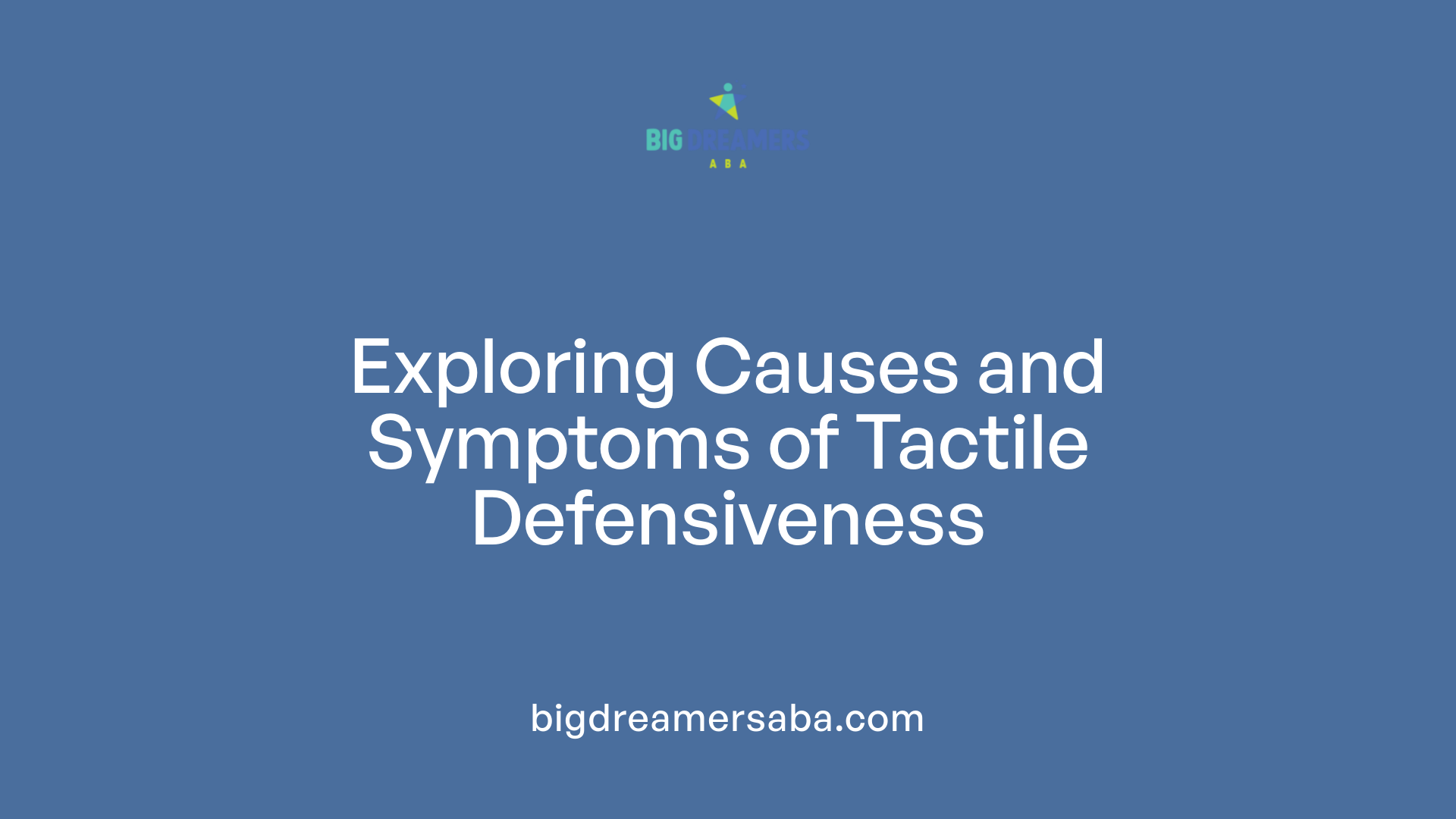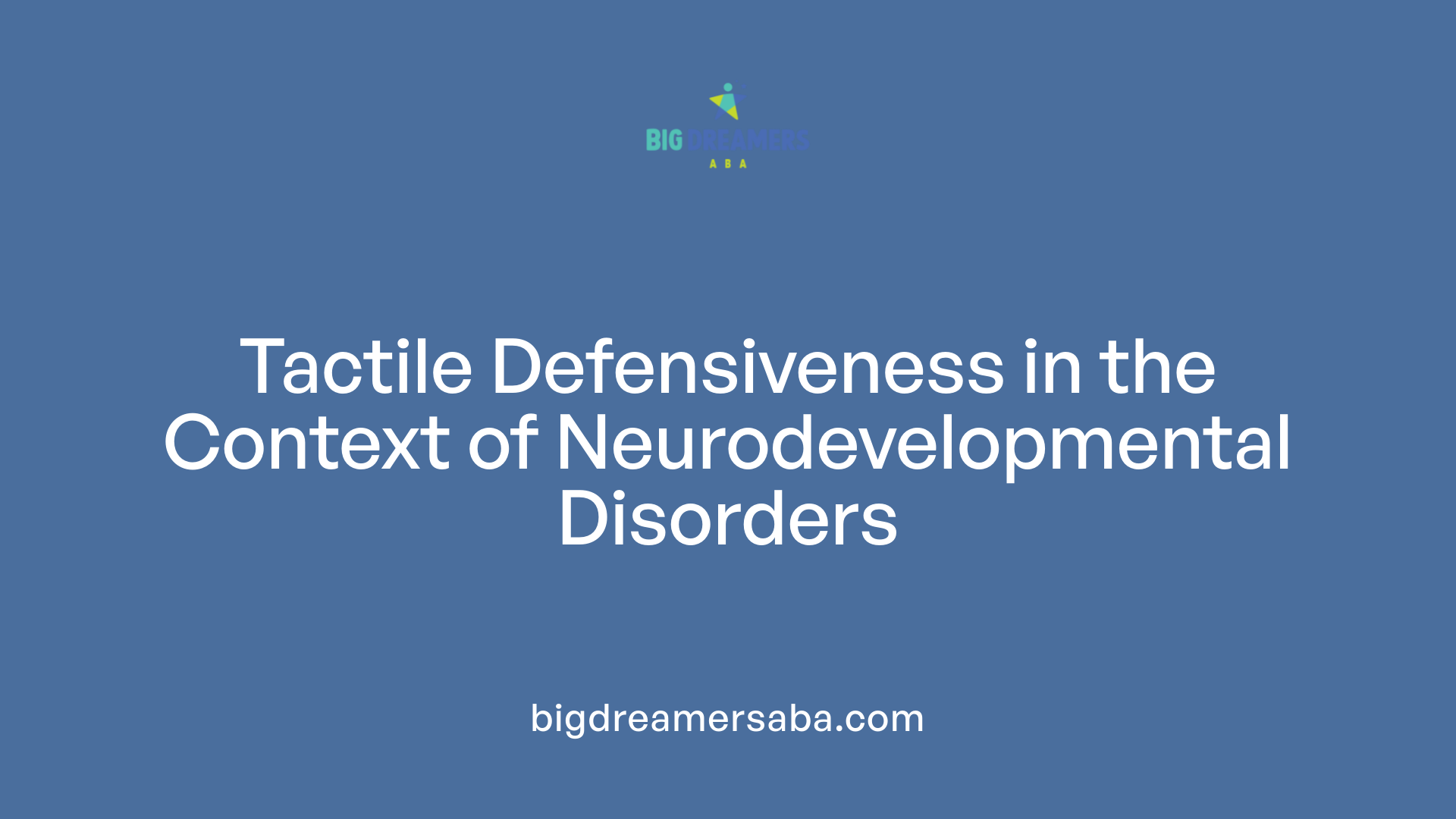Tactile Defensiveness: What Is It?
Exploring the Complex World of Hypersensitive Touch

Understanding Tactile Defensiveness
Tactile defensiveness is a condition where individuals experience heightened sensitivity to touch, making everyday tasks and social interactions challenging. People with this condition perceive commonplace tactile sensations—like clothing tags or gentle hugs—as irritating or even painful. This condition can significantly impact one's daily life and is often associated with broader neurodevelopmental disorders, though it can occur independently as well.
Defining Tactile Defensiveness

What is tactile defensiveness?
Tactile defensiveness is described as a reaction that occurs when someone is highly sensitive to touch, experiencing more sensitivity compared to others. People with tactile defensiveness may find certain touches painful and are often more sensitive to everyday things like clothing textures and hair brushing. This hypersensitivity can lead to significant discomfort in routine activities, making seemingly simple tasks feel overwhelming.
Characteristics of tactile defensiveness
Individuals with tactile defensiveness display a range of characteristic behaviors, often reacting negatively to various textures and sensory inputs. Here are some common characteristics:
- Avoidance of Certain Fabrics: Many individuals may refuse to wear specific clothing textures, such as tags or seams, as they find them irritating.
- Emotional Reactions: These can manifest as irritability, anger, or withdrawal when exposed to light touch or certain tactile stimuli.
- Difficulty in Self-Care: Everyday tasks like tooth brushing or haircuts can become challenging due to heightened sensitivity to touch.
- Messy Play Aversion: Children might avoid play with substances like finger paint or playdough, fearing the sensation of getting their hands dirty.
Understanding these characteristics helps in recognizing how tactile defensiveness impacts daily life and social interactions, allowing for better support and management strategies.
Identifying Causes and Symptoms

What are the causes and symptoms of tactile defensiveness?
The causes of tactile defensiveness are not fully understood, but it is often linked to sensory processing disorders. Research indicates that this hypersensitivity to touch may be due to an imbalance in sensory processing in the brain, resulting in overly heightened reactions to non-threatening tactile stimuli. Genetic factors, environmental conditioning, and even experiences from premature birth may also contribute to sensitivity levels.
Common symptoms and triggers
Individuals with tactile defensiveness can exhibit a range of symptoms which significantly impact daily life. Some of the most common symptoms include:
- Discomfort with Clothing: Children may resist wearing certain fabrics, particularly if they have tags or seams, feeling like a stone in a shoe.
- Sensitivity during Self-Care: Numerous children display unease during grooming tasks such as tooth brushing, nail cutting, and hair cutting, often leading to emotional outbursts.
- Aversion to Messy Play: Many with this condition prefer to avoid textures like glue, playdough, or finger paints, as they can trigger anxiety.
- Resistance to Physical Affection: Children might express discomfort during hugs or close physical contact, leading to social withdrawal.
Common triggers for tactile defensiveness include:
- Textural Sensitivities: Certain fabrics, food textures, or even natural elements like grass and sand can provoke negative reactions.
- Personal Care Activities: Tasks involving direct touch, such as applying lotion or haircutting, can elicit significant discomfort.
Addressing these triggers with understanding and appropriate interventions can help ease the challenges faced by those with tactile defensiveness.
Tactile Sensory Issues in Daily Life
Can you provide an example of a tactile sensory issue?
An example of a tactile sensory issue is tactile defensiveness, characterized by hypersensitivity to touch. Individuals with this condition may find specific fabrics or textures uncomfortable, leading to avoidance behaviors such as:
- Refusing to wear tags or certain clothing items: Some may experience discomfort from seams in socks or the feel of certain materials, prompting them to reject clothing altogether.
- Avoiding messy play: Engaging in activities like finger painting, sand play, or playing with play dough can be distressing, as these tactile experiences clash with their sensitivities.
- Discomfort in self-care tasks: Activities such as brushing hair, washing hands, or even hugging can trigger significant anxiety or aversion. Tactile defensiveness is commonly observed in individuals with sensory processing differences, including those on the autism spectrum and with ADHD. To address these issues, therapeutic strategies often involve gradual exposure to various textures and using firmer pressure during touch interactions to help regulate sensitivity.
What is the impact of tactile defensiveness on daily activities?
Tactile defensiveness can profoundly influence daily living by complicating tasks such as:
- Dressing: Challenges in finding comfortable clothing can lead to frustration during the morning routine. Parents may need to consider multiple fabric options.
- Grooming/Personal hygiene: Activities like tooth brushing and haircuts can provoke emotional reactions due to sensitivity to touch, making these necessary tasks distressing.
- Social interactions: Resistance to physical touch from peers can affect social engagement, with potential impacts on forming friendships or participating in group activities.
Because tactile defensiveness can lead to avoidance behaviors and heightened stress responses, understanding these issues allows parents and caregivers to create supportive environments. Tailored approaches, like encouraging gradual exposure to different textures in a controlled and positive manner, help mitigate these challenges.
Management and Treatment Options

What are potential management strategies and treatment options for tactile defensiveness?
Managing tactile defensiveness effectively requires a multi-faceted approach tailored to the individual’s specific sensitivities. Here are several strategies that can help:
- Sensory Integration Therapy: This therapeutic approach focuses on helping the individual become accustomed to different touch sensations within a controlled and gradual setting. It might involve playful activities designed to encourage tactile exploration without overwhelming the child.
- Occupational Therapy: Engaging an occupational therapist can provide personalized strategies and interventions that cater directly to the child's needs, significantly improving their quality of life. This can include specific exercises and activities that promote sensory processing improvement.
- Deep Pressure Techniques: Incorporating methods like firm massages and using weighted items (such as blankets or vests) has proven calming effects. The consistent, deep pressure helps ground individuals, allowing them to regulate sensory input better.
What therapeutic approaches are effective for tackling tactile defensiveness?
Several therapies and activities can effectively address tactile defensiveness and promote positive outcomes:
- Gradual Exposure to Textures: Engaging in activities like baking, messy play with safe substances, and animal walks can gradually introduce new textures in a fun and non-threatening way. This method encourages comfort while navigating various tactile experiences.
- Creating a Safe Sensory Environment: Establishing a space where the child feels comfortable exploring textures at their own pace is crucial. Allowing the child to dictate their exploration can reduce anxiety associated with unwanted touches.
- Improving Communication and Trust: Informing the child before touching and allowing them to anticipate contact can ease their sensitivities. By fostering an environment of understanding and trust, caregivers can help children feel more secure during potentially distressing moments.
| Technique | Purpose | Examples |
|---|---|---|
| Sensory Integration Therapy | To improve sensory processing abilities | Play-based activities targeting tactile input |
| Deep Pressure Techniques | To calm the nervous system | Weighted blankets, firm massage |
| Gradual Exposure | To reduce anxiety around textures | Messy play, baking, safe touch activities |
| Occupational Therapy | To provide a structured plan for improvement | Customized activities tailored to the child's needs |
Consulting an occupational therapist can be instrumental in exploring the effectiveness of these strategies in managing tactile defensiveness. Each approach provides ways to enhance the child’s ability to cope with daily tactile challenges.
Tactile Defensiveness and Neurodevelopmental Disorders

How does tactile defensiveness relate to neurodevelopmental disorders like ADHD and autism?
Tactile defensiveness can significantly affect individuals with neurodevelopmental disorders (NDDs) such as autism spectrum disorder (ASD) and attention-deficit/hyperactivity disorder (ADHD). While this condition is not solely exclusive to these disorders, there is a notable relationship between them. Many individuals with autonomic nervous system dysregulation, seen in NDDs, often experience heightened sensory processing issues.
The overlap includes common sensory sensitivities that are prevalent in many children diagnosed with ASD and ADHD. For instance, the extreme discomfort with certain textures or touch sensations can manifest in behaviors such as aggression, avoidance, or emotional withdrawal. These responses are often provoked by the very stimuli that may be perceived as harmless by others.
What do research insights reveal about tactile defensiveness and sensory processing?
Emerging research indicates that tactile defensiveness is linked to broader sensory processing abnormalities observed in children with NDDs.
| Research Findings | Description | Implication |
|---|---|---|
| Sensory Processing Challenge | Individuals with tactile defensiveness exhibit heightened reactions to non-threatening touch stimuli. | Indicates a need for focused interventions in therapy. |
| Emotional Responses | There are documented connections between tactile sensitivity and emotional impairment. | Suggests that underlying emotional issues may exacerbate sensory discomfort. |
| Cognitive Factors | Research suggests cognitive and emotional dimensions contribute to tactile defensiveness. | Highlights the complexity of treatment approaches. |
In conclusion, addressing tactile defensiveness is critical for improving daily functioning and quality of life for individuals with ADHD and autism, making awareness and therapeutic intervention essential.
Guidance for Parents and Caregivers

Recognition of tactile defensiveness
Parents and caregivers play a crucial role in recognizing tactile defensiveness, which can significantly affect a child's daily functioning. To identify this condition, be alert for signs such as avoidance of specific textures, discomfort from clothing seams, and reluctance to engage in physical affection like hugs or kisses.
Understanding that tactile defensiveness often coexists with sensory processing disorder or autism helps caregivers appreciate the depth of the issue. Children might react negatively to seemingly benign triggers like certain fabrics, messy play, and grooming tasks, indicating an abnormal response to sensory input.
Strategies for addressing sensitivities
To effectively address tactile defensiveness, several strategies can be implemented:
Create a Sensory-Friendly Environment
- Reduce exposure to irritation triggers by choosing comfortable clothing and avoiding messy textures.
- Organize a calm area where the child feels safe and secure while exploring sensory stimuli at their own pace.
Gradual Exposure to Textures
- Introduce challenging textures slowly without forcing the child, allowing them to adapt gradually.
- Use deep pressure techniques, like weighted items, to help comfort and soothe hypersensitivity.
Implement Sensory Integration Therapy
- Partner with an occupational therapist to provide targeted exercises that assist in processing sensory information more effectively.
- Incorporate playful activities involving various sensations in a structured way.
Encourage Open Communication
- Foster an environment where children feel safe expressing their discomfort or preference, helping to reinforce positive interactions.
- Discuss sensory sensitivities with the child to help them articulate their feelings and experiences.
By employing these strategies, caregivers can better support their children, alleviate anxiety, and enhance their overall quality of life.
The Role of Occupational Therapy
Importance of occupational therapy
Occupational therapy plays a crucial role in supporting individuals with tactile defensiveness. By using tailored strategies, occupational therapists help clients manage hypersensitivity and improve their daily functioning. This form of therapy equips children and adults with the skills needed to better process touch sensations, enhancing their overall quality of life. It fosters an understanding of personal sensory thresholds, allowing individuals to navigate everyday environments more comfortably.
Techniques and assessments used
Therapists utilize various assessments to evaluate sensory processing, such as the Sensory Processing Measure and the Sensory Profile. These tools provide insight into how a person responds to touch and other sensory inputs. Techniques like sensory integration therapy involve gradually introducing different textures in a controlled way, promoting desensitization. Other methods include deep pressure techniques, like massages or the use of weighted items, which help calm individuals and improve their self-regulation. Activities such as animal walks or baking are also integrated to create positive sensory experiences while addressing tactile defensiveness effectively.
Future Directions and Research
Emerging Research on Tactile Defensiveness
Recent investigations into tactile defensiveness are uncovering more about its neurological underpinnings and how it relates to sensory processing disorders. Researchers are studying the origins of heightened reactions to touch, with findings suggesting genetic, environmental, and developmental factors contribute to the sensitivity experienced by individuals. Furthermore, some studies are exploring the connection between emotional regulation and tactile defensiveness, indicating that emotional impairments may amplify sensory sensitivities.
Potential Advancements in Treatment
Innovative treatment approaches are on the rise, focusing on tailoring sensory integration therapies to individual needs. One promising area is the use of technology, such as virtual reality environments designed to gradually expose individuals to varied tactile sensations in a controlled manner. Additionally, ongoing research into weighted therapy tools indicates a positive impact on self-regulation and anxiety management for those with tactile defensiveness. As studies continue, understanding the specific needs of tactile defensive individuals will enhance therapy effectiveness and improve their quality of life.
Embracing a Sensory-Friendly Approach
Addressing tactile defensiveness requires a compassionate understanding of the sensory challenges faced by individuals. By integrating therapy, creating supportive environments, and fostering open communication, those affected can lead more comfortable and fulfilling lives. As research progresses, there is hope for enhanced treatment strategies and a better quality of life for those dealing with hypersensitivity to touch.
References
- What is Tactile Defensiveness or Touch Sensory Sensitivity?
- Tactile Defensiveness Explained + Tactile Sensory Activities
- What Is Tactile Defensiveness And How To Lessen ...
- Best Sensory Strategies for Handling Tactile Defensiveness
- Signs of Tactile Defensiveness in Your Child
- Noli Me Tangere: Social Touch, Tactile Defensiveness, and ...
- Tactile Defensiveness: What it is and what to do. -
- CLASI Tactile Defensiveness
- Sensory Defensiveness - Physio.co.uk
Recent articles

How to Create a Structured Home Environment for Children with Autism

Why ABA Therapy Helps Children Build Confidence Through Skill Mastery
